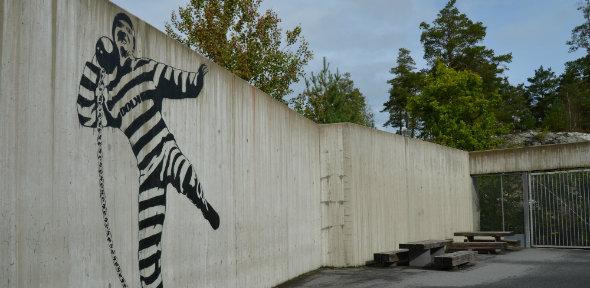
Distance from freedom, distance from life
Thomas Ugelvik – University of Oslo, Norway
The data excerpt below is taken from a conversation I had with a prisoner in Kongsvinger prison, Norway’s only prison designed to hold exclusively foreign national prisoners. All prisoners at Kongsvinger are supposed to be either transferred to prisons in their home countries to serve out some proportion of their sentence there, or rearrested at the end of their sentence and deported back to their countries of origin by Norwegian immigration police. Several of the prisoners I had already talked with resisted deportation as best they could. Some had family and friends in Norway, and the threat of deportation was a perennial concern for them. Other prisoners, however, wanted nothing more than to be put on a plane by police:
I just want to go home! I want to be deported, so what is taking so long? What is the problem? Please deport me! I have talked with my contact officer, he says it is possible, but it will probably take some months, call your lawyer. I try to call my lawyer, I have called a hundred times! Really, a hundred times! But no, no contact. It’s typical, when the case is finished, lawyers are quiet, they forget about you, they need new cases, need to make more money. And I have talked with my embassy three times, they tell me yes, is possible to serve the rest of the sentence in Romania. … Two weeks ago, another prisoner was deported to Romania. Why did they not take me as well? It would be cheaper, yes? Easier? They are going anyway? I don’t get it. (fieldnotes, Kongsvinger prison)
The prisoner emphatically asked to be transferred back to his home country of Romania as quickly as possible. In the current Norwegian political context, this may come as a surprise. Politicians in favour of strict immigration policies frequently argue that a prison sentence is not enough to deter foreign national criminals. Deportation at the end of the sentence is the ‘real punishment’ and an important deterrent in its own right. Politicians arguing for more liberal and humane immigration policies claim that deportation is inhumane and in most cases disproportionate. Some even say that adding deportation to a criminal sentence constitutes double jeopardy and that it is thus illegal. And here I was, talking with this prisoner who was basically begging for deportation. What was going on?
There is considerable variation between institutions known as ‘prisons’. Different prisoners may even experience the same prison wing very differently. Recent prison scholarship has developed a set of spatial/physical metaphors that can be used to capture variations between the experiences of different prisoners. The ‘depth’, ‘weight’, ‘tightness’ and ‘breadth’ framework allows for sensitive and nuanced analyses of the phenomenology of imprisonment. The more this literature grows, the better we will be able to understand the nuances and variations found in the institutions we call ‘prisons’.
According to Crewe, (2015) ‘deep’ imprisonment refers to the experience of being far away from the ‘surface’ of freedom. ‘Depth’ is often seen as connected to the prevailing levels of security and control: very high-security regimes can create a feeling of being buried far beneath the surface. The experience of ‘depth’ will therefore often be connected to the degree of physical freedom permitted to prisoners, and the level of bodily control they are subjected to.
Most prisoners would agree that Kongsvinger prison, and in particular the low-security wing where the prisoner in question was staying at the time, is relatively shallow. There is no real prison wall, just a low fence that could be climbed over. Prisoners can apply for escorted and unescorted leave, including visits to the local library. Under this regime, most prisoners would not have a sense of being buried far beneath the surface of freedom. But ‘depth’ is always relative to a specific sense of a ‘surface’. And to many foreign national prisoners, the ‘surface’ is not right there outside the prison – the freedom waiting just beyond the prison wall. The ‘surface’ is rather the world of families and loved ones, of struggling spouses and children they have never have got to know properly. And they are all far away, off in another country, and difficult or impossible to keep in touch with. Regardless of what we might call the ‘objective shallowness’ of Kongsvinger, many prisoners felt as if they were buried deep beneath the surface, far away from a life in another country that just carried on without them. We therefore wish to suggest a difference between ‘depth’ as the distance from freedom and ‘depth’ as the distance from life. To many prisoners, the relative shallowness of the low-security wing at Kongsvinger did not mean that they did not feel captured deep beneath the surface represented by the life of families and loved ones far away. Human experience is given meaning in particular symbolic meaning-making contexts; therefore scholars who want to understand the experiences of prisoners in particular prison regimes also have to pay attention to these contexts. If there is a difference between ‘depth’ as the distance from freedom and ‘depth’ as the distance from life, many foreign national prisoners at Kongsvinger feel deeply buried in the latter sense, even though they are given ample opportunity to sample freedom outside the prison walls on a regular basis.
This blog entry is based on a paper I am working on together with Dorina Damsa.
Crewe, B (2015), "Inside the Belly of the Penal Beast: Understanding the Experience of Imprisonment". International Journal of Crime, Justice and Social Democracy 4 (1), 50-65.

 The Comparative Penology Group is led by Dr Ben Crewe and his research team who, since 2016, have been working on a five-year project titled: 'Penal policymaking and the prisoner experience: a comparative analysis'.
The Comparative Penology Group is led by Dr Ben Crewe and his research team who, since 2016, have been working on a five-year project titled: 'Penal policymaking and the prisoner experience: a comparative analysis'.
